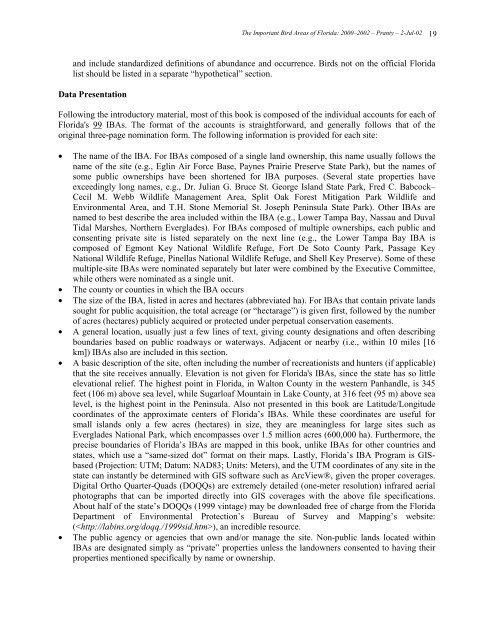The Important Bird Areas of Florida - National Audubon Society
The Important Bird Areas of Florida - National Audubon Society
The Important Bird Areas of Florida - National Audubon Society
Create successful ePaper yourself
Turn your PDF publications into a flip-book with our unique Google optimized e-Paper software.
<strong>The</strong> <strong>Important</strong> <strong>Bird</strong> <strong>Areas</strong> <strong>of</strong> <strong>Florida</strong>: 2000–2002 – Pranty – 2-Jul-02 19and include standardized definitions <strong>of</strong> abundance and occurrence. <strong>Bird</strong>s not on the <strong>of</strong>ficial <strong>Florida</strong>list should be listed in a separate “hypothetical” section.Data PresentationFollowing the introductory material, most <strong>of</strong> this book is composed <strong>of</strong> the individual accounts for each <strong>of</strong><strong>Florida</strong>'s 99 IBAs. <strong>The</strong> format <strong>of</strong> the accounts is straightforward, and generally follows that <strong>of</strong> theoriginal three-page nomination form. <strong>The</strong> following information is provided for each site:• <strong>The</strong> name <strong>of</strong> the IBA. For IBAs composed <strong>of</strong> a single land ownership, this name usually follows thename <strong>of</strong> the site (e.g., Eglin Air Force Base, Paynes Prairie Preserve State Park), but the names <strong>of</strong>some public ownerships have been shortened for IBA purposes. (Several state properties haveexceedingly long names, e.g., Dr. Julian G. Bruce St. George Island State Park, Fred C. Babcock–Cecil M. Webb Wildlife Management Area, Split Oak Forest Mitigation Park Wildlife andEnvironmental Area, and T.H. Stone Memorial St. Joseph Peninsula State Park). Other IBAs arenamed to best describe the area included within the IBA (e.g., Lower Tampa Bay, Nassau and DuvalTidal Marshes, Northern Everglades). For IBAs composed <strong>of</strong> multiple ownerships, each public andconsenting private site is listed separately on the next line (e.g., the Lower Tampa Bay IBA iscomposed <strong>of</strong> Egmont Key <strong>National</strong> Wildlife Refuge, Fort De Soto County Park, Passage Key<strong>National</strong> Wildlife Refuge, Pinellas <strong>National</strong> Wildlife Refuge, and Shell Key Preserve). Some <strong>of</strong> thesemultiple-site IBAs were nominated separately but later were combined by the Executive Committee,while others were nominated as a single unit.• <strong>The</strong> county or counties in which the IBA occurs• <strong>The</strong> size <strong>of</strong> the IBA, listed in acres and hectares (abbreviated ha). For IBAs that contain private landssought for public acquisition, the total acreage (or “hectarage”) is given first, followed by the number<strong>of</strong> acres (hectares) publicly acquired or protected under perpetual conservation easements.• A general location, usually just a few lines <strong>of</strong> text, giving county designations and <strong>of</strong>ten describingboundaries based on public roadways or waterways. Adjacent or nearby (i.e., within 10 miles [16km]) IBAs also are included in this section.• A basic description <strong>of</strong> the site, <strong>of</strong>ten including the number <strong>of</strong> recreationists and hunters (if applicable)that the site receives annually. Elevation is not given for <strong>Florida</strong>'s IBAs, since the state has so littleelevational relief. <strong>The</strong> highest point in <strong>Florida</strong>, in Walton County in the western Panhandle, is 345feet (106 m) above sea level, while Sugarloaf Mountain in Lake County, at 316 feet (95 m) above sealevel, is the highest point in the Peninsula. Also not presented in this book are Latitude/Longitudecoordinates <strong>of</strong> the approximate centers <strong>of</strong> <strong>Florida</strong>’s IBAs. While these coordinates are useful forsmall islands only a few acres (hectares) in size, they are meaningless for large sites such asEverglades <strong>National</strong> Park, which encompasses over 1.5 million acres (600,000 ha). Furthermore, theprecise boundaries <strong>of</strong> <strong>Florida</strong>’s IBAs are mapped in this book, unlike IBAs for other countries andstates, which use a “same-sized dot” format on their maps. Lastly, <strong>Florida</strong>’s IBA Program is GISbased(Projection: UTM; Datum: NAD83; Units: Meters), and the UTM coordinates <strong>of</strong> any site in thestate can instantly be determined with GIS s<strong>of</strong>tware such as ArcView®, given the proper coverages.Digital Ortho Quarter-Quads (DOQQs) are extremely detailed (one-meter resolution) infrared aerialphotographs that can be imported directly into GIS coverages with the above file specifications.About half <strong>of</strong> the state’s DOQQs (1999 vintage) may be downloaded free <strong>of</strong> charge from the <strong>Florida</strong>Department <strong>of</strong> Environmental Protection’s Bureau <strong>of</strong> Survey and Mapping’s website:(), an incredible resource.• <strong>The</strong> public agency or agencies that own and/or manage the site. Non-public lands located withinIBAs are designated simply as “private” properties unless the landowners consented to having theirproperties mentioned specifically by name or ownership.
















